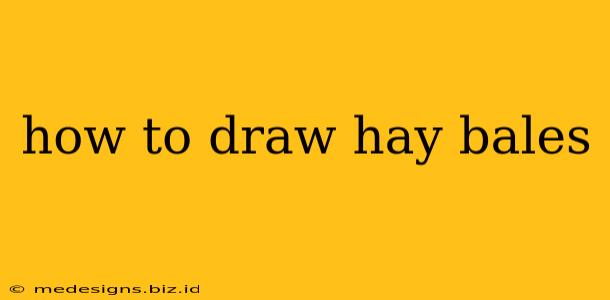Want to add a touch of rustic charm to your drawings? Learning how to draw hay bales is easier than you think! This guide will walk you through various techniques, from simple sketches to more detailed representations, perfect for artists of all skill levels. Whether you're aiming for a realistic depiction of a farm scene or a whimsical cartoon style, we've got you covered.
Basic Hay Bale Shape: The Rectangular Approach
Let's start with the fundamentals. Hay bales are, at their core, rectangular shapes.
Step 1: The Foundation Rectangle
Begin by lightly sketching a rectangle. This will be the base of your hay bale. Don't worry about making it perfect; slight imperfections add to the natural look of a hay bale.
Step 2: Adding Dimension
To give your hay bale some depth, add slightly curved lines to the sides and top. Hay bales aren't perfectly geometric; they slump and settle, creating rounded edges.
Step 3: Texture and Shading
Use shading to suggest the texture of the hay. Softer shading around the edges will create a sense of softness and roundness. Consider adding darker shadows to the areas where the bale would naturally cast shadows.
Beyond the Basics: Adding Details and Variations
Once you've mastered the basic rectangle, let's explore more advanced techniques:
Adding String or Twine
Many hay bales are bound with twine or string. Add these details by drawing thin, slightly uneven lines around the bale.
Depicting Different Types of Hay Bales
Hay bales come in various sizes and shapes. Experiment with drawing square bales, round bales (these are more challenging but achievable with some practice!), or even smaller, irregularly shaped bales.
Creating a Hay Bale Stack
Drawing a stack of hay bales adds depth and interest to your artwork. Overlapping bales create a sense of realism and perspective. Remember to vary the size and position of each bale for a more natural appearance.
Adding Background Elements
Enhancing your drawing with complementary elements adds context and realism. For instance:
- Farm setting: Include a barn, fence, or other farm elements.
- Rustic landscape: Add trees, fields, or rolling hills.
- Animals: Include animals like cows, horses, or sheep interacting with the hay bales.
Style and Technique Exploration:
Your style choices will significantly affect your hay bale drawing:
- Realistic style: Focus on accurate proportions, shading, and detail for a photorealistic approach.
- Cartoon style: Simplify shapes, use bold lines, and minimize detail for a fun, playful look.
- Impressionistic style: Focus on capturing the essence of the hay bale through color and brushstrokes rather than precise detail.
Practice Makes Perfect!
The key to mastering hay bale drawings (and any drawing, really!) is practice. Experiment with different techniques, styles, and levels of detail. Don't be afraid to make mistakes – they're part of the learning process. Start with simple sketches, gradually adding complexity as your confidence grows.
By following these steps and practicing regularly, you'll soon be able to draw realistic and charming hay bales to enhance your artwork. Happy drawing!
